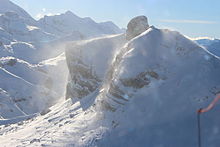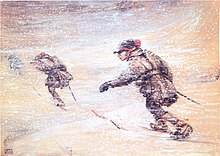Snowdrift


A snowdrift (also snow cornice or - in Germany - Snowdrift is called) Snow , who does not like is by the usual snowfall evenly on the ground, but by the wind has been shipped off to the side. Mostly it is powder snow, as it is lighter than damp snow and can therefore be blown away more easily. The material of a snowdrift is solidified by the impact of the snow particles. The initially loose snow then takes on a rigid form.
Snow drifts can arise anywhere on wide areas, but also in corners or hollows, where, in addition to wind turbulence, there are also calm zones and the snow is more easily deposited. It can pile up meters high - as so-called drift snow - while almost no snow remains in the area. Snow drifts are very difficult to predict because their formation depends on local conditions.
Traffic obstruction
Snow drifts on roads or train tracks are uncomfortable and dangerous . When approaching from a distance, it is difficult to see that there is a snowdrift, or how high it is. Vehicles driving into massive snowdrifts at high speed can sometimes only be pulled out again with heavy equipment ( armored recovery vehicles ).
High snow drifts cannot be removed with a snow plow , only with a snow blower . However, if the weather remains the same, drifts can arise again in a very short time.
Even small so-called snow tongues are uncomfortable to drive through, as you usually don't expect them to occur and you don't reduce your speed in time. A skidding can easily be the result.
Snow protection

The risk of snow drifts can be reduced by setting up slatted frames ( snow gates ) and plastic nets ( snow fences ). These reduce the wind speed on the leeward side, so that the snow is deposited next to the gate or the net. However, the precise setting up of these protective devices requires experience, as small wind turns render them ineffective or possibly increase the drifts.
Another way to reduce snow drifts is to use snow protection planting: single or multiple rows of trees with branches down to the bottom that catch the snow carried by the wind.
See also
- Cornices
- Windkolk - free space behind an obstacle created by the wind
- Drift snow
- Topic list road traffic

